 We left work early on a Thursday afternoon, came home, packed the car and then we were off - driving in heavy traffic through Dubai and Sharjah, before it eased out while continuing through Ajman, Um Al Quwain and Ras Al Kaimah. (Knowing better now, we'll take the Emirates Road all the way to RAK - so much quicker and easier!)
We left work early on a Thursday afternoon, came home, packed the car and then we were off - driving in heavy traffic through Dubai and Sharjah, before it eased out while continuing through Ajman, Um Al Quwain and Ras Al Kaimah. (Knowing better now, we'll take the Emirates Road all the way to RAK - so much quicker and easier!) This area was all new to M who had only been as far north as Ajman - and it is vastly different to the urban sophistication that is Dubai. UAQ and RAK are much less developed and more rural - although this is bound to change over the next few years. We saw our first on-land oil drilling platform in RAK!
The UAE Dahra/Oman Tibat border proved to be an interesting time - UAE was easy, but the confused Omani military border guard (maybe the sight of 2 women travelling without male companions proved too much for the poor man!) was quickly replaced by a more knowledgeable civilian who took over, typed our names into the computer, (no one would ever be able to find us from what he typed!), stamped our passports and we were free to drive into Oman.
Dusk fell as we drove along the amazing coastline on a beautiful road that had been carved out of the rocky hillsides and reclaimed from the sea. As darkness enveloped us, we reached our destination - Khasab - the stepping stone to the fjords of Oman, and a very quiet little town boasting a fishing port and an airport with a runway as long as the town is deep.
The Esra apartments were clean and basic - just what we needed for 2 nights. We unpacked the car and then got straight back into it to drive back up the coast to the Golden Tulip Hotel for dinner. The Ramadan buffet was delicious - lots of seafood and local delicacies. After dinner, we sat out on the wide terrace to enjoy the warmth and watch the activities of the hotel guests.
Arriving back at the apartment, we were keen to check out the 200 channel satellite TV to see what we could find. There were about 30 Italian channels, 50 Arabic, 30 that didn't work, 2 English (BBC News and music), 10 German (one of us was happy!), 8 French - and the rest were p*rn! We couldn't believe what we were seeing on the screen in a Muslim country!
The 7:30am knock at the door came all too early, but we were dressed and headed up to the rooftop for a breakfast of boiled eggs, cereal, toast, coffee, tea and fruit juice. The apartments were full of people from Dubai, and after breakfast we formed a convoy in our 4WDs behind the travel agent who escorted us to the harbour, where we boarded our dhows for a day of cruising on the fjords of the Musandam.
If anyone wants to go into this region, call Khasab Travel to arrange it. They booked everything for us and gave us all the necessary documentation for the border controls - even instructions on how to get to Khasab from Dubai!

We were lucky - of the 5 dhows that were in the harbour, we reckoned that we got the best. Our skipper was Mohammed and his crewman was also Mohammed! Captain Mo was a modern-thinking Muslim who loved Bob Marley, so we cruised all day listening to the Rasta sounds of BM and the Wailers, interspersed with Arabian music whenever we came closer to the other dhows which were captained by more 'traditional' Omani skippers!

5 mins out of the harbour saw the first of 3 encounters with dolphins. These guys were the biggest that we've seen - some were over 2 meters long and had pronounced humps. The mother and calf were funny as mum was determined to be protective, until baby pushed its way to be closer to the dhow to get the best ride on the wave. It was beautiful to watch these gorgeous creatures effortlessly surfing the waves and keeping pace, often jumping sideways out of the water to look at us through one eye.
Cruising into Khor Ash Shamm was awe-inspiring and we were all very quiet as our eyes struggled to take in the incredible scenery and apply some sense of scale to what we were seeing. Huge cliffs and mountains soared into the sky straight out of the water. 'Khor' is Arabic for fjord, and the tourist marketing likens them to the Norwegian Fjords. All M could think of was that it was a bigger Milford Sound with wider water - there was even a mountain shaped like Mitre Peak!
 In the company of other dhows, we cruised around the fjord as Mohammed told us some of the history of the villages and the other sights that we were seeing. Sometimes the scenery battled for supremacy - dolphins, mountains, villages, turtles, stingrays, other dhows - it was a visual assault!
In the company of other dhows, we cruised around the fjord as Mohammed told us some of the history of the villages and the other sights that we were seeing. Sometimes the scenery battled for supremacy - dolphins, mountains, villages, turtles, stingrays, other dhows - it was a visual assault!Although known to the local Omanis, Khor Ash Shamm was discovered by the British in 1820. In the khor is Telegraph Island which was a manned British communications station between 1864 and 1869. The cable stretched from India, through Oman and into neighbouring countries westwards until it reached England. It was the principal line of communications between Mother England and the Indian colonies. The building foundations are still visible, and the whole island is surrounded by coral and tropical fish which makes it a popular spot for the dhows to anchor, and let their passengers jump overboard to explore the undersea life.


Of course, we did just that! We even did our bit for conservation when we found a fish pot full of reef fish. We untied it and let the inedible and smarter reef fish go free, while the dumber edible fish like the hammour stayed in the pot, as if resigned to their fate! M tried out her new underwater housing for her Canon, and although the water was silty she managed to get some reasonable shots. As the day drew to an end, we cruised out of the khor and headed back to Khasab, pausing for another brief swim and snorkel on the way.
After a quick shower back at the apartment, we headed up the Wadi Sal Al A'la valley behind Khasab for a look at the only accessible-by-road fjord - Khor Najd. We briefly hesitated before going up the road to the fjord, as there were military warning notices telling people not to enter the area because of target practice! Once we had established that they meant the fenced area behind the sign, we continued onwards and upwards. Wow - the road up was incredible, the road down the other side was a rally driver's dream, and the view of the fjord at dusk was spectacular.
 We were blown away, and just stared at the scene until lack of light and hunger made us think about dinner. It was back to the only restaurant in town at the Golden Tulip Hotel. Inspired by what we had already seen, we were really looking forward to the next day's travels further up into the Hajjar mountains behind Khasab.
We were blown away, and just stared at the scene until lack of light and hunger made us think about dinner. It was back to the only restaurant in town at the Golden Tulip Hotel. Inspired by what we had already seen, we were really looking forward to the next day's travels further up into the Hajjar mountains behind Khasab.8am the next morning saw us again having breakfast on the rooftop, and this time we were entertained by the airport staff using a road sweeper to clean the incredibly long runway at the little airport, and by a military helicopter that took off and soon looked insignificant as it disappeared over the mountains on its way to Muscat. Just as we hit the gravel road heading out of town into the Wadi Sal Al A'la valley, we saw the reason for the airport activity. With all landing lights ablaze, coming towards us over the mountains was a military Hercules C-130 transporter plane. We stopped to admire the pilot's skills as he skimmed over the mountains, dropped into the valley, turned sharp right, lined the plane up with the runway and made a perfect landing. Now we knew the reason for the long runway: heavy military planes!
Soon we were leaving the flat valley floor and climbing the first of many steep inclines into the Hajjar mountains. This mountain range is like a spine that runs the entire length of Oman, in roughly a north to south direction. We were at the very northern tip. M was a little cautious at first, as this was the first gravel trip in the Honda MRV 4WD. It continues to impress us as a practical and reliable vehicle, and the V6 engine and torque make it an ideal offroad and gravel traveller, as well as being safe and comfortable to drive in the city.
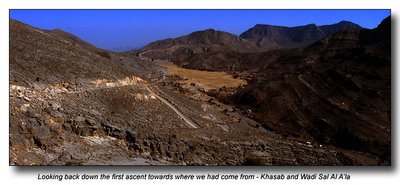
 After the first climb of a couple of thousand feet, we ran out of superlatives to describe the scenery that we were seeing around every corner, and were reduced to silent, wide-eyed wonder as we absorbed the beauty of our surroundings.
After the first climb of a couple of thousand feet, we ran out of superlatives to describe the scenery that we were seeing around every corner, and were reduced to silent, wide-eyed wonder as we absorbed the beauty of our surroundings.There were small uninhabited villages, (the people live on the coast in Summer and return to the mountain homes in Winter), built into seemingly impossible terrain, and the natural rock formations and vegetation features were awesome.

We could see areas where the water must run down the mountains and over the roads during Winter. It must be truly spectacular to see this, as well as a little scary too, as it would most likely wash away the road, and anything else in its path.
We encountered very few people as we drove along. The local Omanis were incredibly friendly - waving and calling out greetings - even the women in full abayas and face pieces (we have yet to find out what these are called) would wave to us. The tourists were less friendly, barely managing small greetings, and we saw a few white-knuckled, pale-faced drivers as they navigated the gravel roads!

Sayh Plateau was at the very top of the steep climb up the northern face of the mountain range. It's 1800 metres above sea level, and is a farming area and settlement. In Winter, it looks like a green lake with all sorts of crops such as alfalfa, wheat, radishes and onions. It was largely uninhabited and very brown as we drove through. The people had yet to move back from the coast.
It was strange seeing empty houses, and thinking that people are so trusting - and trustworthy - that properties can be left uninhabited and not broken into. Try leaving a whole village abandoned in most western so-called 'civilised' countries and see what happens!
Climbing out the other side of the Sayr Plateau saw the vegetation start to change from what we had been seeing. There were more greener low-lying scrub plants, and it looked very different to the rocky cliffs that we had experienced on the ascent to the plateau. The terrain was now more hilly than mountainous, and this continued for a while as we climbed up to the highest point on our journey, and in the Musandam - Jabal Harim. We could see it towering above us for quite some distance - very distinguishable by the huge 'golfball' structure on the 2,087m summit. This was obviously a communications post of some sort, and as we got closer to the top, the warning signs against trespassing into military zones made us think that it was a strategic Omani listening post - perhaps also associated with the UAE military. We received friendly waves from the gun-toting guards as we passed the gate, and we were careful to pass out of sight and hearing before we stopped the MRV at the top of the road to take photos of where we had come from, before driving on to drop down the other side.
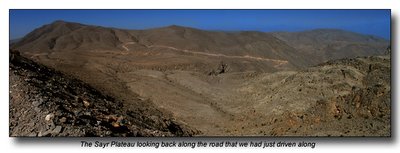 If you're still reading - good on you!
If you're still reading - good on you!Nothing could prepare us for what we saw on the other side of Jabal Harim - suffice to say that we felt the Grand Canyon tremble in its boots at the competition. Unlike the GC with its multitude of visitors, this place was largely deserted and absolutely silent. We knew that there were people in the listening post behind us, and we could see a 4WD on the long plateau way below us - but it was so quiet, and the silence lent to the grandeur and beauty. We felt as if we had been beamed to another planet. In the below image, you can see the terraced farming areas where winter rains are trapped for the cultivation of crops and for livestock drinking water. Water for human consumption is trucked in, and the Omani government pays for all water supplies to the Omani people. Very cool, that! We passed many water tanks at the tops of tracks that led to dwellings whose inhabitants depended on the water deliveries from the sweet-water wells on the low-lying areas closer to the ocean.
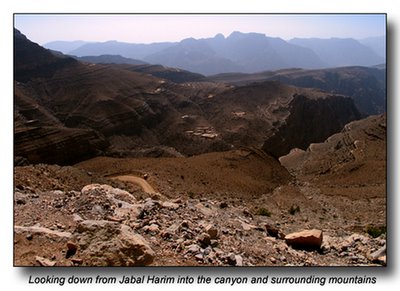 Of course, we had to take another shot of our beloved 4WD - we felt as if we were in a photo shoot for Honda!
Of course, we had to take another shot of our beloved 4WD - we felt as if we were in a photo shoot for Honda!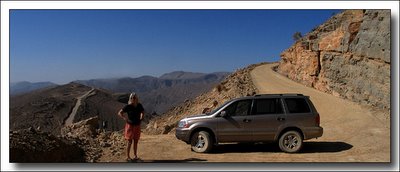 It was getting to the point where we couldn't turn a corner without another photo opportunity. We wound our way along the track, heading for the Rawdah Bowl at the bottom of t
It was getting to the point where we couldn't turn a corner without another photo opportunity. We wound our way along the track, heading for the Rawdah Bowl at the bottom of t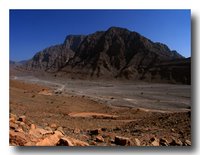 he mountains. The vegetation had again changed and we were now seeing lots of thorny Acacia trees as well as the usual low-lying shrubs.
he mountains. The vegetation had again changed and we were now seeing lots of thorny Acacia trees as well as the usual low-lying shrubs.As we stopped the Honda for another photo, another 4WD rumbled to a halt beside us. In it was a delightful Omani man who proceeded to have an animated conversation with M - he in Arabic and she in English! Neither had a clue what the other was saying, but it went on for a couple of minutes with the only recognisable word to M being 'Khasab' - to which she nodded! When M held up her camera,
 he stopped talking so that she could take his picture. Then, after she uttered 'Shukran' (thank you) to him, (one of the very few Arabic words that M does know!), he was off with a friendly wave and in a cloud of dust. It made us both smile from ear to ear - and we felt happy and lifted from the encounter - it was all good!
he stopped talking so that she could take his picture. Then, after she uttered 'Shukran' (thank you) to him, (one of the very few Arabic words that M does know!), he was off with a friendly wave and in a cloud of dust. It made us both smile from ear to ear - and we felt happy and lifted from the encounter - it was all good!Following the old man's vehicle, we suddenly came across the Omani/UAE border control point as we left the Rawdah Bowl. Beyond the barrier, the road forked and to the right was the road to Ras Al Kaimah. To the left was the road to the port of Dibba, which is half Omani, half UAE territory, and on the east coast of the peninsular. We had travelled 58 kilometres from Khasab - roughly half the distance to Dibba.

The old man and his truck were waved across the border like old friends, but we were a different story. We had been warned that we may be turned back and have to return the way we came, and after our passports were inspected at length by 2 friendly, smiling border guards and 1 guy dressed in civvies who could speak a little English, we were indeed asked to return to Tibat where we had crossed over. We have decided that we also have to do the road to the border from the Dibba end, as what we had seen so far was truly beautiful, and had left us eager for more adventure.
On the way back, we further explored the Rawdah Bowl and turned off the main road into a valley that led to a small town with an equally small airstrip. We waved to the teams of Indian powerline workers who were up the poles and polishing the ceramic conductors! We came across a very picturesque cemetery with a tiny mosque that was towered over by the mountain guardians.
 The access road in and out of the valley ran smack in the middle of the flat ground, with beautiful rugged mountains towering each side. It was a very spiritual place and M felt the eyes of a million years upon her, as she stopped for photos, and a pee behind a large rock!
The access road in and out of the valley ran smack in the middle of the flat ground, with beautiful rugged mountains towering each side. It was a very spiritual place and M felt the eyes of a million years upon her, as she stopped for photos, and a pee behind a large rock! The journey back to Khasab was faster because of the familiarity with the road; less frequent photo stops; M getting used to the Honda on gravel. J didn't think much of her 'intentional' attempts to hit every rock with the right-hand wheels, but what did she expect on a gravel road? To be fair, M was also hitting rocks with the left-hand wheels, it's just that J couldn't feel those ones when sitting on the right!
The journey back to Khasab was faster because of the familiarity with the road; less frequent photo stops; M getting used to the Honda on gravel. J didn't think much of her 'intentional' attempts to hit every rock with the right-hand wheels, but what did she expect on a gravel road? To be fair, M was also hitting rocks with the left-hand wheels, it's just that J couldn't feel those ones when sitting on the right!We drove back to the Omani/UAE border and passed through with ease - heading back to Dubai with a detour into Um Al Quwain, where neither of us had been before. It sure is quiet there, in comparison to Dubai! We can now say that we've driven through the main towns in all 7 emirates that comprise the UAE.
Our next adventure will be to tackle the gravel track from Dibba to Ras Al Kaimah without crossing over the Omani border when we go to Fujairah (Dibba) for a day of diving in the Musandam. There will also be a 4 day excursion into Oman on the east coast, to visit Muscat in December.
Interspersed with the various road trip stories, we'll be posting experiences from our time spent in other countries as well as times in Dubai and the UAE. We hope that it's interesting enough to make you come back now and then to read more of what we're up to.
A warning to all of our friends and family who stop to stay with us over a weekend or two - we'll be taking you on at least one of these adventures! There's so much to see and do in this part of the world, and now that we're spending less time in planes travelling on business and more time in Dubai, we have lots of chances to explore the region. It's fun, and gives us a break from the anonymous entity that is Dubai. Travelling to lesser developed areas proves to us that this country does have an old soul, spirit and friendly people, and is not all about marketing hype, stress and glitzy facade.
It makes us feel alive!

7 comments:
Hi M & J,
Wow, this is great - how did you do this? Is the site your own or Through something else????
Would love to do this.
Vanessa
Hey!
Our first guest to leave a comment - and I love that it's you!
Setting this up is easy and free.
Just log onto
Blogger.com
and follow the steps to create your own blog!
Look foward to reading yours!
love
m
Good morning! Oooh I enjoyed your trip. I'm going to make another cup of tea and get settled for more. What a great blog. Thank you for a really good start to my weekend!
I can see that you're starting at the very beginning! :-)
Dibba tour is very enjoyable because there is a vast range of things to enjoy. The natural sceneries of Musandam Dibba are very beautiful and have no match in the whole world.
Musandam Khasab Youre so cool! I dont suppose Ive read anything like this before
Musandam Khasab is a great place, i really want to visit it as soon i can, can u please tell me about the hotels there?
Post a Comment